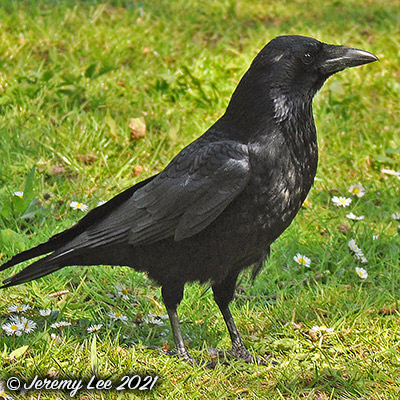
 |
|
Scientific Classifications explained » Amphibians » Ants » Aphids » Bees » Beetles » Birds » Bugs » Butterflies » Caterpillars » Damselflies » Dragonflies » Earwigs » Flies » Frog/Leafhoppers » Fungi » Galls » Grasshoppers » Harvestmen » Hoverflies » Lacewings » Ladybirds » Leaf Mines » Lichens » Mammals » Millipedes » Mosses » Moths » Sawflies » Slugs » Snails » Spiders » Trees & Shrubs » Wasps » Wild Flowers » Woodlice » Postboxes |
UK Nature > Birds > Corvus corone

Scientific Name: Corvus corone Common Name: Carrion Crow Corvus corone, more commonly known as the Carrion Crow, is a black crow, about the same size as a Rook (Corvus frugilegus), but unlike the Rook, the Carrion Crow has neatly feathered thighs, and feathers around the base of the beak. While at first appearance its plumage is black, on closer inspection it has a green and purple iridescence. In flight, the Carrion Crow has a shorter head than the Rook, as well as having slower wing beats. The tail is squarer in the Carrion Crow, and the "fingers" at the wing tips are less splayed. Juvenile Carrion Crows have duller, browner plumage and pale blue eyes; the adults have brown eyes. The Carrion Crow has many calls but the most common is "kraa-kraa-kraa". They have a diverse diet: worms, insects, fruit, seeds, kitchen scraps, eggs, and young birds. Typically, a Carrion Crow's nest is built in the fork of a tree, cliff edge or even electricity pylon and is a large construction of twigs lined with hair and bark. It is built by both birds. The duties of incubating the eggs are performed by the female. The eggs are about 43 mm by 30 mm, smooth and glossy, pale bluish-green with dark brown and grey markings. Both adults feed the young. |
|

https://www.uknature.co.uk is a website dedicated to showing the immense diversity of UK nature and wildlife. Our vast range of habitats, from lowland arable to snow covered mountains, from storm-ravaged coastlines to peaceful inland freshwater lakes and rivers, from dry, sandy heaths to deciduous and coniferous forests, all these habitats contribute to the abundance of UK nature. We have wild birds in huge numbers either residing or visiting our shores (597 recorded species as at July 2013) and we must also not forget the humble back garden with its grass lawns, flower beds filled with nectar rich flowers, shrubs and trees, all designed to attract huge numbers of insects such as bees, moths, butterflies and hoverflies; and finally the small ponds which provide safe havens for frogs, toads, newts and even slow worms and grass snakes. www.uknature.co.uk is the showcase for my personal passion, photographing uknature in all its glory. I sincerely hope you all enjoy the fruits of my labours. This site and all images contained therein is © Jeremy Lee 2004 - 2025. All Rights Reserved. Site design by Jeremy Lee. Site development & IT Support by Stuart Lee. |